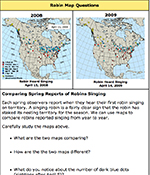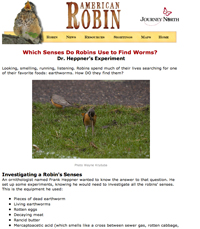Migration Update: April 14, 2009
Your Sightings! >>
Today's Report Includes:
|
 |
|
|
| Highlights:
A
Big Push
North! Winnipeg,
MB Beresford,
NB Good question! Do you think any of those robins are singing yet? Today's Map Questions considers that topic. |
|
You've now heard some NOP news, but many NOPs are still waiting for their first robins to arrive — or to sing. Have robins reached the NOP way north at Shageluk (62.65 N,-159.79 W)?
Check it out, and see if there's still time for you to enter the Early Bird Contest. (You could win a Journey North T-shirt!)
In
the photo study that began this report, did you guess the robin
was digging up a worm? One observer
noted what a robin does as it looks for worms: It takes
a few steps, cocks its head, and then dives its beak into the ground.
The observer wondered: "Are Robins able to hear the
worms or feel them?"
How would you go after the answer? An
ornithologist (bird scientist) named Frank Heppner did experiments
to
investigate
robins senses. He used this equipment: pieces of dead
earthworm, living earthworms, rotten eggs, decaying meat, rancid butter, mercaptoacetic
acid (which smells like a cross between sewer gas, rotten cabbage, a skunk, and
a stinkbug), a small drill, and a tape recorder that was extremely sensitive
at
low frequencies.
- If you had the materials Frank Heppner used, how would you design experiments to prove which sense(s) robins use to find worms? Why do you think he used each of these materials?
After you read about Dr. Heppner's experiments and conclusions, add to your journal entry. >>
Reports from citizen scientists like you give clues about what comes after migration is complete. What are you seeing?
Sauk Centre, MN: "Spied 2 robins in fir trees in my window, looking for a nesting spot." (4/09/09) >>
Columbus, OH: "A pair of robins has nested in a pine tree, and has been incubating eggs for 4 days now." (4/10/09) >>
Brownton, MN: "Around 8:30 this morning my husband noticed a robin carrying dried grass up into our birch tree close to our front garden. After watching awhile, we realized she was trying to build a nest. I immediately went outside and filled a suet basket with horse hair and also made a mixture of black dirt and water (mud) in a 12" plant saucer. I set them both out in our front garden close to the robin's raisin tray." (4/11/09) >>
Think about why this observer set out such things for the robin. Read on:
Robins follow "nest-building blueprints" in their brains. Instinct tells them how to build the perfect structure to hold the eggs they're about to lay. The perfect robin nest must serve as a snug baby cradle to keep the eggs and babies warm, dry, and safe. It must also have room for the mother robin to hunker down to incubate her young. How do they build such a terrific cradle? Give it a try with human-made blueprints!
The Next American Robin Migration Update Will Be Posted on April 21*, 2009 (Migration Data Only).












